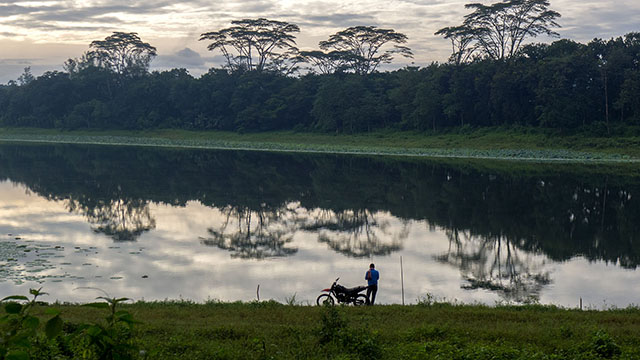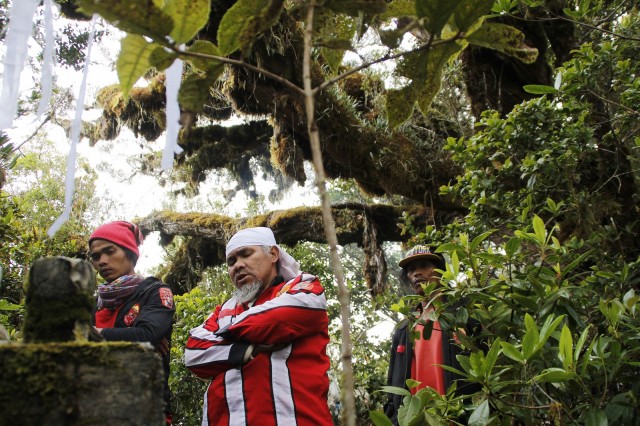 The 60-hectare Lake Pinamaloy is the source of potable water for the municipality of Don Carlos in southern Bukidnon. It is situated just beside the poblacion. MindaNews file photo by Bobby Timonera
The 60-hectare Lake Pinamaloy is the source of potable water for the municipality of Don Carlos in southern Bukidnon. It is situated just beside the poblacion. MindaNews file photo by Bobby Timonera
MALAYBALAY CITY (MindaNews / 18 January) – Strengthening environmental governance, including revisiting of the 2008 Bukidnon Declaration on the Environment and a review on the province’s environment code, is among the expectations expressed by stakeholders in their response to the Bukidnon 2018: Public Outlook Series initiative.
Ms. Marie Angeli C. Abendaño, faculty member of the Natural Sciences Department of Bukidnon State University said she expects continued community-based forest management in the province’s uplands.
“It helps protect our watersheds, secure our water and prevent climate change-induced disasters such as landslides and flood, which have been recurring in our province,” she added.
Ma. Easterluna Canoy, executive director of the Kitanglad Integrated NGOs, has pushed for another Bukidnon Environment Summit, to follow up on the declaration that was agreed upon during the first summit almost 10 years ago.
Around 100 stakeholders attended the summit in Valencia City on June 26-27, 2008 that led to the crafting of the “Bukidnon Environmental Declaration of 2008.”
The participants ended the two-day gathering with 42 recommendations in the areas of local governance in important biodiversity and conservation areas, government and private sector partnership in sustainable natural resources and environmental management, and indigenous peoples’ and community participation, among others.
But nothing much has been heard about the declaration since.
 A view of Mt. Kitanglad Range in Barangay Sil-ipon, Libona, Bukidnon. MindaNews file photo by H. Marcos C. Mordeno
A view of Mt. Kitanglad Range in Barangay Sil-ipon, Libona, Bukidnon. MindaNews file photo by H. Marcos C. Mordeno
Canoy, one of the conveners, said the review summit will enable the stakeholders, including the government, to act together to ensure conservation of the province’s natural resources.
She added it will push them to provide an accounting of their works, advocacies and commitment to realize their pledges made in the 2008 summit.
In 2008, a provincial level follow-up committee was to be set-up to take stock of the accomplishments.
“If it’s really serious in its environmental advocacies, Bukidnon can take the lead in environmental programs and initiatives that will benefit not only people of Bukidnon but the rest of Mindanawons,” Canoy said.
In 2018, let Bukidnon province be the watershed model on environmental or in ecological governance, she added.
Datu Makapukaw Adolino Saway, chieftain of the Talaandig tribe and head of the Council of Elders of Mt. Kitanglad said that to achieve conservation, stakeholders, including government, should give more thrust and recognition, not discrimination, to the spirit of biodiversity.
In an earlier conversation, he clarified that in saving the environment, it is not only environmental laws that matter. There are aspects that are invisible and not recognized by government but are important to consider.
Canoy said there is a need to balance the benefits of relevant customary traditions with that of environmental policies that would ensure sustainability amid the dangers of climate change.
Vice Governor Alex P. Calingasan, who chairs the provincial board committee on environmental protection backed the idea of reconvening the Bukidnon Environment Summit, to assess what has been achieved. He vowed to co-organize the summit within the year.
 Lumads (indigenous peoples) perform a ritual for the spirit guardians of the forest. MindaNews file photo by H. Marcos C. Mordeno
Lumads (indigenous peoples) perform a ritual for the spirit guardians of the forest. MindaNews file photo by H. Marcos C. Mordeno
He also eyed a review of the Bukidnon Environment Code, passed and approved in March 2001, to update some provisions which may already be obsolete.
Roland Lacson, legislative researcher at the provincial board, said that since 2007 there were already discussions in the body to review the code for the same reason cited by Calingasan.
He cited, for example, that the code was passed when policies on climate change adaptation had not been articulated in local government yet.
He said the provincial board members noticed that the code did not have enough provisions on regulation of water resources.
“Before only rice lands and other farms would need irrigation. But eventually more farm types required big water supply,” he said.
He said that board members noted too the water rights applications of farms planted to high value crops like banana and pineapple.
“Almost every river or stream has been covered with applications before the NWRB (National Water Resources Board),” he added.
The NWRB seeks a certification of posting of public notice on the application from the provincial board.
Daniel Somera, Mt. Kitanglad Protected Area Superintendent said he wished for a lush and greener Bukidnon province with the strong support of more environment-conscious citizens.
Kris Guerrero B. Tabernero, supervising environmental management specialist at the Malaybalay City Environment and Natural Resources Office, said he expects that all applicable measures will be undertaken by local government units in protecting, restoring and enhancing the environmental quality of Bukidnon.
“With due consideration of the principle of ecological sustainable development,” added Tabernero, head of the environmental management division.
He said it can be done by coordinating activities, programs and policies from the barangay to the provincial level.
Emma Molina of the civil society group Barog Bukidnon cited the need to give more attention to reforestation specifically of areas within the six major watersheds of the province.
“(It must also) check on the current situation of the headwaters and seek the national government’s attention and urgent implementation of the proposed Tagoloan River Basin Management Project as has been presented five years ago by the Mindanao Development Authority with the Department of Environment and Natural Resources Region 10,” she said.
She said the project will not only help beautify and prevent damages due to floods and other calamities in Bukidnon and neighboring provinces.
“These will also help, provide jobs, livelihood and the basic needs among the needy, especially the indigenous peoples of Bukidnon,” she added.
But Molina said citizens also have a stake in the situation of the environment in Bukidnon.
“Everyone should be more concerned about what has been happening to our environment, considering the damages incurred at times of calamities caused by too much extractions of natural resources,” she said. (Walter I. Balane with a report from Efraem O. Egoc/Development Communication intern from Bukidnon State University)
[BUKIDNON 2018: PUBLIC OUTLOOK SERIES is a community journalism project that seeks to provide space for the public to speak up on the future of the province in 2018. The editorial team sent text messages and sought interviews with random sources from different sectors in the province from December 25 to 28, 2017. The responses were consolidated and categorized thematically and then used as bases for stories in these pieces. React to waltzib@gmail.com.]
